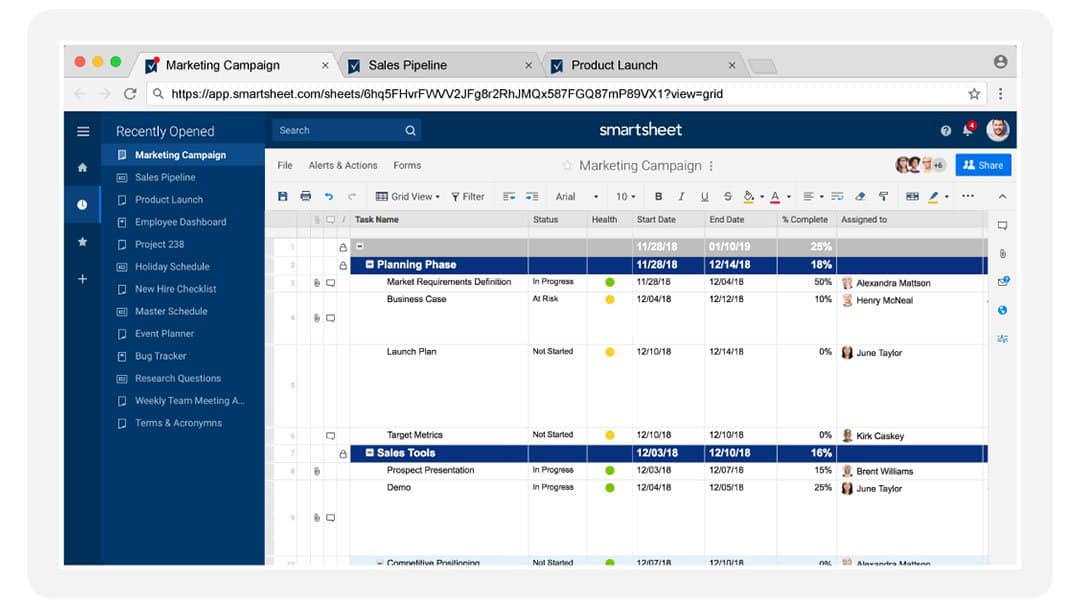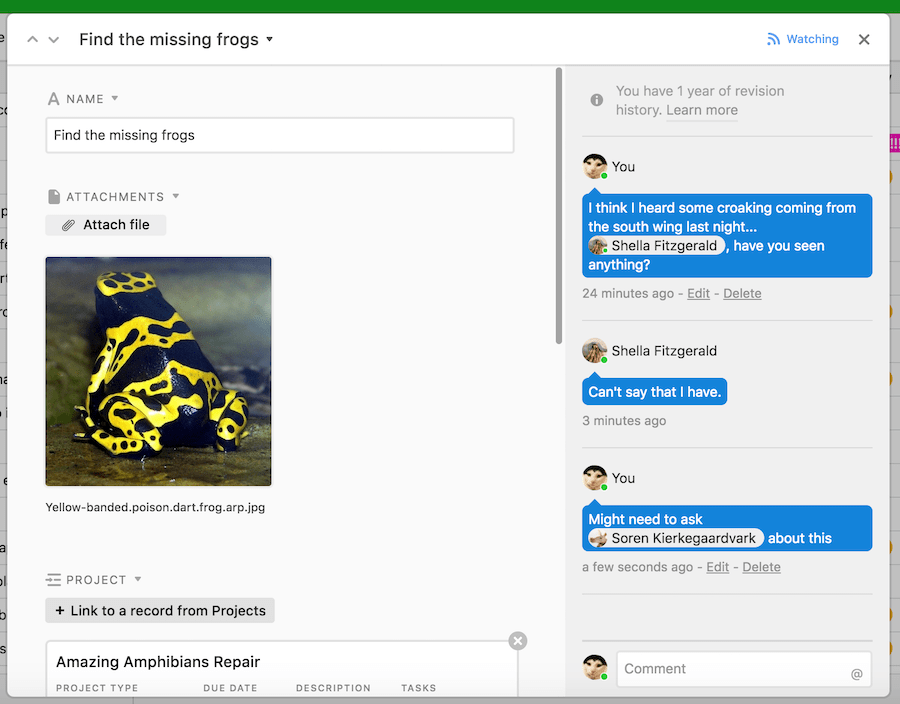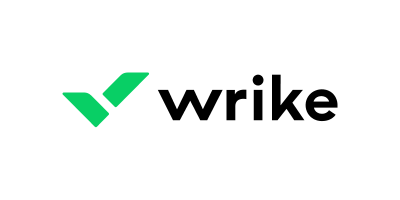Smartsheet and Airtable are both cloud-based tools that can be used for project management and take their design cues from spreadsheets. While they may look similar at first glance, there are fundamental underlying differences that impact how each tool operates. In this guide, we compare Smartsheet and Airtable to help you figure out if one of them is right for your business.
Jump to:
- Smartsheet vs. Airtable: Comparison table
- Smartsheet and Airtable pricing
- Feature comparison: Smartsheet vs. Airtable
- Smartsheet pros and cons
- Airtable pros and cons
- Should your organization use Smartsheet or Airtable?
What is Smartsheet?

Smartsheet is a workflow and project management tool that mimics the look of a spreadsheet. This cloud-based tool can be accessed via your web browser, desktop apps for Windows and Mac or mobile apps for iOS and Android.
What is Airtable?

Airtable is a cloud-based collaboration tool that allows teams to build their own custom low-code apps and to create and share relational databases. Airtable can be accessed via your web browser, desktop apps for Windows and Mac or mobile apps for iOS and Android.
SEE: 5 best Airtable alternatives for managing your projects in 2023
Feature Comparison: Smartsheet vs. Airtable
| Features | Smartsheet | Airtable |
|---|---|---|
| Multiple project views | Yes | Yes |
| Project templates | 350+ | 20+ |
| Team collaboration | Yes | Yes |
| Native time tracking | Yes | Yes |
| Forever free plan | Yes | Yes |
| Pricing | Starts at $7 per user per month | Starts at $10 per user per month |
Featured partners
Smartsheet and Airtable pricing
Smartsheet pricing
Smartsheet offers four different pricing plans:
- Free: This forever free plan covers one user, up to two editors, and two sheets.
- Pro: This plan costs $7 per user per month billed annually and covers up to 10 editors and unlimited sheets.
- Business: This plan costs $25 per user per month billed annually and covers unlimited editors.
- Enterprise: This plan requires a custom pricing quote from Smartsheet and includes extra features such as single sign on and directory integration.
In addition to the forever Free plan, Smartsheet offers a 30-day free trial of the Business plan so you can try it before you buy. For more information, see our full Smartsheet review.
Airtable pricing
Airtable also offers four pricing plans:
- Free: This forever free plan covers up to five editors or creators and offers unlimited bases.
- Plus: This plan costs $10 per seat per month billed annually and offers six-month revision and snapshot history and automatic table syncing.
- Pro: This plan costs $25 per seat per month billed annually and offers Gantt and timeline views and granular interface permissions.
- Enterprise: This plan requires a custom pricing quote from Airtable and includes extra features such as unlimited workspaces and unlimited extensions.
In addition to the forever Free plan, Airtable offers a 14-day free trial of the Pro plan so you can try it before you buy. For more information, see our full Airtable review.
Feature comparison: Smartsheet vs. Airtable
Project views and templates
Smartsheet combines project management tools with a familiar spreadsheet-like interface, a.k.a. the grid view. You can also switch to Gantt chart view, calendar view or card view, the latter of which is a kanban-style interface. Smartsheet offers over 350 templates to speed up the set-up process, or you can build a project from scratch. Some template examples include individual task tracking (Figure A), an email campaign plan and a cost tracking template.
Figure A
![]()
Airtable isn’t only a project management tool; one of the apps that you can build in the platform is a project tracker. By selecting the default project tracker template, Airtable will automatically create a base and fill it with sample data to help get you started. There are also 20 additional project management templates that you can choose from if the default one doesn’t fit your needs. Free accounts come with grid (Figure B), calendar, form and kanban views — but you’ll need to upgrade to a Pro account if you want Gantt chart or timeline views, which is a bit of a drawback.
Figure B

Task management
Smartsheet and Airtable offer all the fundamental task management features you would expect. However, they use slightly different language to describe things, which can make it confusing for potential users that are unfamiliar with either platform. For instance, Smartsheet calls a project a “sheet” while Airtable calls it a “base” (short for database). Smartsheet sometimes refers to a task as a “row” while Airtable occasionally calls tasks “records.”
Both systems allow you to share a project with teammates, assign a task to yourself or someone else and set deadlines for tasks. Both also offer native time tracking abilities, so you don’t need a separate platform. However, Airtable considers time tracking an extension (or extra feature), and lower-tier plans are limited in how many extensions you can use per base. For example, the free plan only gets one extension per base.
You can upload attachments and files in each tool, albeit in a slightly different way. Smartsheet lets you upload files to both the entire sheet and a specific row depending on your needs. In Airtable, you must create an attachment field before uploading the desired document, which adds an extra step to the process.
For more information, see our article about how to use Airtable as a project management tool.
Team collaboration
Both Smartsheet and Airtable allow you to comment on items, tag colleagues in messages and reply to comments (Figure C) directly within the tool. However, neither service allows you to react to comments with an emoji such as thumbs up or smiley face, which is a feature that most other enterprise project management software provides. This means that you will need to leave a reply every time you want to acknowledge a coworker’s comment, which users say can be annoying.
Figure C

Furthermore, neither platform offers direct messages like Asana or a native video chat option like Teamwork. While these additional features aren’t as standard as emoji reactions, they’re still helpful. You’ll need to move to a different software such as Slack or Zoom if you want to have an extended discussion, especially one that isn’t tied directly to a particular task.
Figure D

Integrations
Currently Smartsheet offers 84 integrations, while Airtable offers 34. Both connect with popular email and calendar clients such as Outlook and Gmail, document management services like Box and Dropbox, and CRMs such as HubSpot and Salesforce.
However, their integrations don’t overlap as much as you might expect. For instance, Airtable has native integration with project management apps such as Asana and Trello, while Smartsheet syncs with a lot of data visualization tools such as Power BI and Qlik. You can also connect each software to thousands of more apps through Zapier.
SEE: 8 best healthcare project management software for 2023
Smartsheet pros and cons
Pros of Smartsheet
- Spreadsheet-based design will be familiar to many.
- Over 350 project templates available.
- Excellent security protocols.
- Comprehensive reporting and analytics.
Cons of Smartsheet
- Occasionally pages don’t update in real time and autosave can glitch.
- Some features like resource management are extra paid add-ons.
- Doesn’t replicate all Excel features.
- Spreadsheet-based design feels outdated compared to other kanban-style apps.
Airtable pros and cons
Pros of Airtable
- Highly customizable and flexible platform that goes beyond project management.
- Interface designed tool is very granular.
- Real-time data updates allow for team collaboration.
- Integrates with many different apps.
Cons of Airtable
- Must pay for a Pro plan to get Gantt charts and timeline views.
- A bit of a learning curve due to all the features.
- Not as powerful as dedicated spreadsheet software.
- Complex interface can make it unnecessarily complicated to add information.
Review methodology
To compare Smartsheet and Airtable, we consulted demo videos, product documentation, user reviews, and community resource forums. We considered factors such as pricing, interface design, ease of use and integration as well as features such as project views, task management, team collaboration and project templates.
Should your organization use Smartsheet or Airtable?
Smartsheet is more of a “true” project management tool, with all the features you would expect for that. On the other hand, Airtable is more of a database management tool with some project management features. As such, each can be a good fit for different use cases.
If you live in Excel, then you’ll probably enjoy Smartsheet’s spreadsheet-based design. However, it can feel somewhat outdated compared to other Smartsheet alternatives such as monday, Wrike and ClickUp. Smartsheet does offer a solid selection of project management features, but its traditional design is what sets it apart. If you’re not committed to the spreadsheet-like interface, then it might be worth looking into some other competitors that offer similar (or better) functionality in a more updated design.
On the other hand, if you’re mostly looking to manage data and build low-code team apps in a single system, Airtable is the right choice for you. While its databases are formatted like spreadsheets, you can use the tool to do much more than run formulas or plan projects, such as gathering customer feedback and tracking sales. In fact, some teams choose to use Airtable for their data management needs and a different app (such as Smartsheet) for their project management needs. You could potentially use both together and integrate them using Zapier.
Not sure if either Smartsheet or Airtable is right for your needs? Check out our list of the best project management software for 2023.
Featured project management software
1 Wrike
Wrike is the ultimate solution for managing projects.
Discover the power of Wrike's award-winning project management software. Maximize productivity using Gantt charts, Kanban boards, and calendars. Streamline resource allocation, drive team alignment, and enhance forecasting. Benefit from AI-driven automation to save time on admin. Deliver impressive results, hit deadlines, and stay within budgets while elevating your team's performance.











